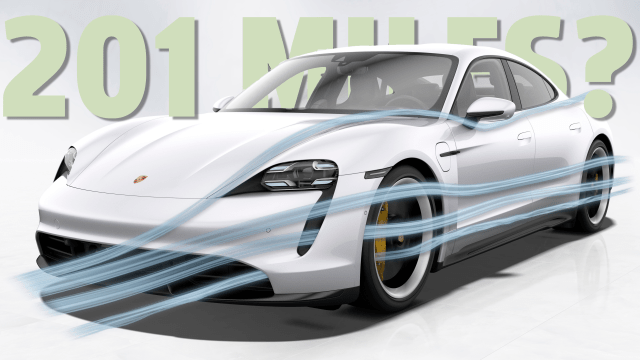This week, we learned the U.S. Environmental Protection Agency rated the new 2020 Porsche Taycan Turbo’s range at just 201 miles (323 km) on a charge. That’s worse than almost every other electric car on sale today, and far worse than the 300 miles (480 km) Porsche teased a couple of years ago, so what made the EPA figure so low?
There are two very clear factors that resulted in the Porsche Taycan Turbo coming in with less range than the Nissan Leaf, Chevy Bolt Jaguar I-Pace, Audi E-Tron, Mercedes-Benz EQC, and every Tesla on sale today.
The first has to do with electric vehicle range estimates in general. As expertly explained already by our pal Mack Hogan, legacy manufacturers like Porsche and others have struggled to meet Tesla’s impressive range figures, like 370 miles (595 km) for the Model S Long Range, to prevent reliability and maintenance issues. Here’s how Mack put it:
Essentially, traditional manufacturers have customers that are less likely to accept drive unit failures, battery replacements and quality concerns that Tesla early adopters often write off as a small price to pay for a car from the future. And, without the sort of growth-is-everything valuation of a Silicon Valley tech firm, Volkswagen’s shareholders are less likely to tolerate stratospheric warranty costs.
So you could argue that Porsche is just being careful that its first EV doesn’t become well known for having too many problems. Porsche would rather uphold a reliable reputation than risk it pushing the Taycan’s mechanics to beat the Model S on power, range, and 0 to 60 mph (97 kmh) times.
But the the other issue specific to the Taycan’s EPA-estimated 201-mile range has to do with the way the EPA does its efficiency tests based on regulations from the Society of Automotive Engineers (SAE International). .
Over in Europe, the Taycan Turbo posted a promising 280-mile (450 km) range estimate from the new WLTP protocol over there. But the EPA does things differently from that protocol.
The EPA figure accounts for hot and cold condition testing, which the WLTP does not, and they can do it two ways. The first EPA protocol runs a five-cycle test, which finds how efficient the car would be in ideal conditions on the city and highway, alongside more testing in more extreme conditions to de-rate the car back down to what could be a more realistic estimation.
The other way to do it is to run only a two-cycle test, the city and highway cycles. But the EPA still requires a de-rating for a more conservative estimate and to avoid any chance of misleading customers. If an automaker chooses just the two-cycle test, a de-rating factor of 0.7 is applied to the estimate, cutting down the range.
Here’s a little more detail on the test procedure, from FuelEconomy.gov:
Electric Vehicle – Adjustment Procedure used to Derive FE Label (Window Sticker) Estimates
EPA regulations require fuel economy, energy consumption, CO2 and driving range values listed on the FE Label (window sticker) to be adjusted to more accurately reflect the values that customers can expect to achieve in the real world.
EPA currently allows fuel economy, energy consumption, CO2 values, and range values listed on the FE Label (window sticker) for electric vehicles to be adjusted using one of the following methods:
by multiplying city/highway fuel economy and range values by 0.7 and dividing city/highway energy consumption and CO2 values by 0.7
using the derived 5-cycle method described in 40 CFR 600.210-12(a)(2) and EPA guidance letter CD-15- 15, June 22, 2015 (available here)
using a method which is equivalent to the vehicle specific 5-cycle method described in 40 CFR 600.210- 12(a)(1) (with prior EPA approval) such as the method provided in Appendix B of SAE J1634 July 2017 Recommended Practice;
using adjustment factors which are based on in-use data (with prior EPA approval). Currently, most EVs use the first or third method (the 0.7 factor)
If you do some backwards maths and take the Taycan’s 201 mile (323 km) de-rated EPA range estimate and divide it by the 0.7 de-rating factor, you get 287 miles (461 km). That means the Taycan must have achieved an estimated range of 287 mile (461 km) on the EPA’s two-cycle test, which closely aligns with the WLTP’s 280-mile (450 km) range estimate, as well as Porsche’s own third-party test resulting in 275 miles (442 km) of range.
Keep in mind that this does not mean you can go back to other EVs sold in the U.S., divide by 0.7, and reasonably expect that number to be accurate. You have to know how the car was tested for certification, based on one of the methods outlined above.
Unfortunately, electric vehicle testing is complicated, both globally and locally here in the U.S., which can make it difficult for the average car shopper looking at a window sticker to understand.
But what’s actually happening is automakers are taking it upon themselves to protect their reputation by perhaps holding back their equipment a little bit to ensure reliability and consistent performance, not just the biggest number they can hit.
That, and the government is also keeping figures conservative to ensure buyers don’t blame them for unreasonable expectations on range, even if the EPA could do a little better job explaining exactly how a car can lose over 80 miles (128 km) of range between driving in the U.S. versus driving it in Europe.
